Movements of Millions Say No to Gene Drives as Brazil Attempts to Legalize Genetic Extinction Technology
Submitted by Dru Oja Jay on
FOR IMMEDIATE RELEASE
MONTREAL, MEXICO CITY, SÃO PAULO, February 22, 2018—The largest rural movements in Brazil, representing well over a million farmers, are protesting a new Brazilian regulation that would allow release of gene drives, the controversial genetic extinction technology, into Brazil’s ecosystems and farms.






